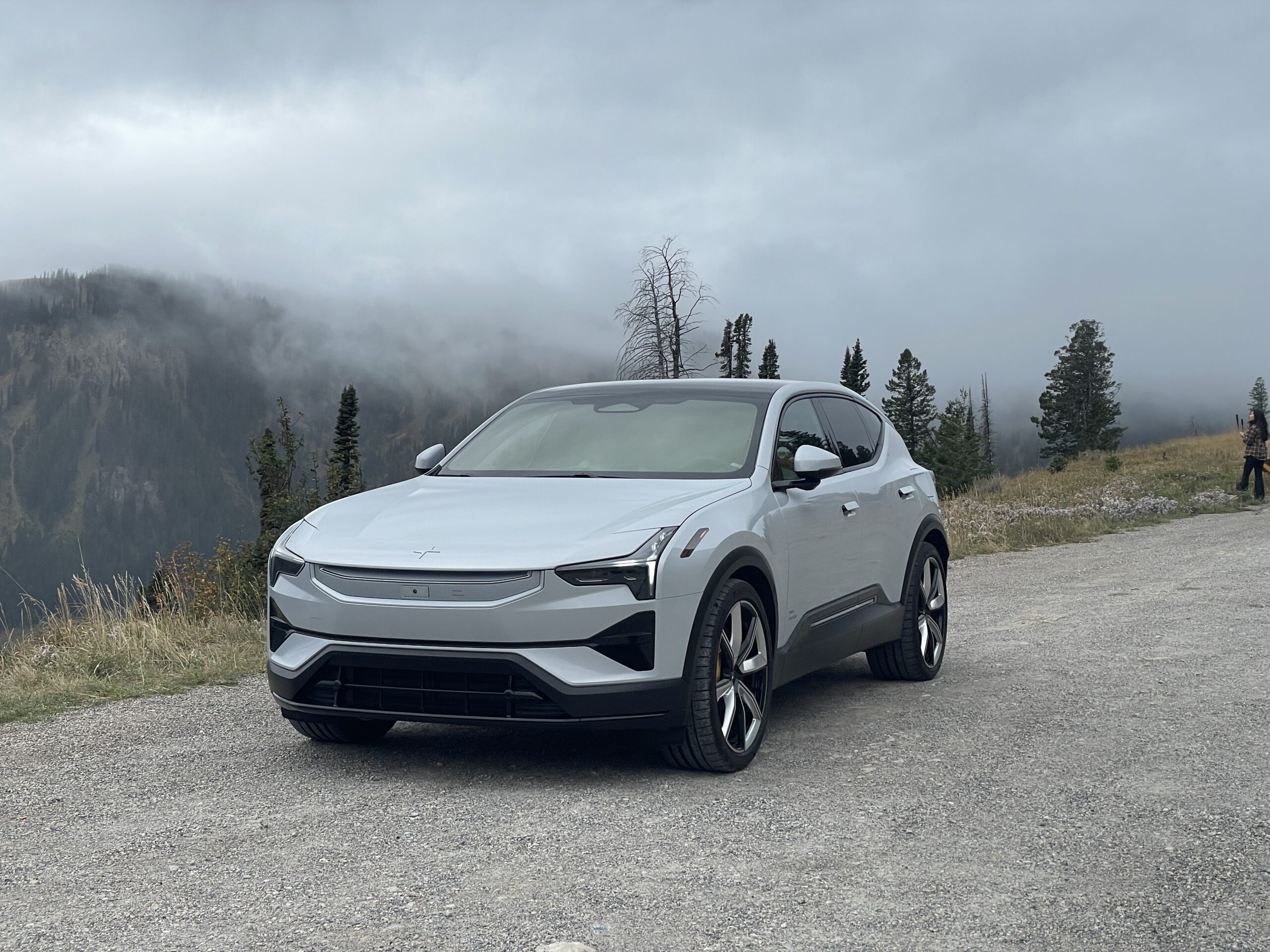Sign up for daily news updates from CleanTechnica on email. Or follow us on Google News!
The latest installment of the ongoing seminar series on global decarbonization that I’m leading for India’s utility professionals under the auspices of the India Smart Grid Forum was on carbon capture and sequestration (CCS). It’s an overly hyped, overly hoped for solution that isn’t and won’t scale remotely economically. When you are at the bottom of a hole digging, the first solution is to stop digging, not to have teaspoons of dirt thrown into the hole by someone else. Transcript, slides, and embedded webinar are here for those who like to listen-listen or read-read.
Reji Kumar Pillai (RKP): Good morning, good afternoon, good evening. Warm welcome to all the participants. Thank you for joining the last webinar. I got stuck in some ministry I couldn’t join in the beginning to moderate. So today, despite other engagements, I made sure I am right in front. This is a subject which we are going to talk about today, current carbon capture. This is a subject which has not made much of development or it has gone at scale in the last several decades. Personally, in my young days as a training engineer in the early eighties, I had the opportunity to attend a few workshops which were presented to the NDPC National Thermal Power Corporation. So some experts from overseas came and they presented that all the NDPC thermal power plants should install CC as we used to call those days.
Carbon capture and sequestration usage was not there in the eighties. So that is, CCS became CC us only in the last ten years. So different companies, different forums, different settings. We’ve been seeing this technology, but it has not made the way many other technologies which have progressed in the last four decades. We are not seeing that kind of progress here. And one of the main reason India why this went very slow is because or nobody were very long on this is because we use coal which is for thermal power stations and many other fossil fuel industry. We use coal which has a very high sulfur content. So before the two or three CCS technologies which have been tried out or piloted that need to have the sulfur content of the coal need to be reduced.
So what they have been doing, installed a desulfurization unit in the flow gas which comes out of the boiler desulfurization unit and then taking the flow gases to the carbon capture unit. So which makes the whole thing very expensive and unviable. I’m sure no other technology which has come where the Indian coal could go through and directly into carbon capture and it can be tried. So we’ll hear more about it. Why this is not a technology which is going to help in decarbonization, the net zero journey of any of the countries. This technology is not likely to help in the next 2030 years. So despite that, a lot of billions of dollars of investor money is flowing into startups who are claiming that they have solutions, but I have not seen any which has been implemented at scale.
So without taking any more time, I will hand it over to Michael who will take us through a presentation. Thank you Michael, over to you.
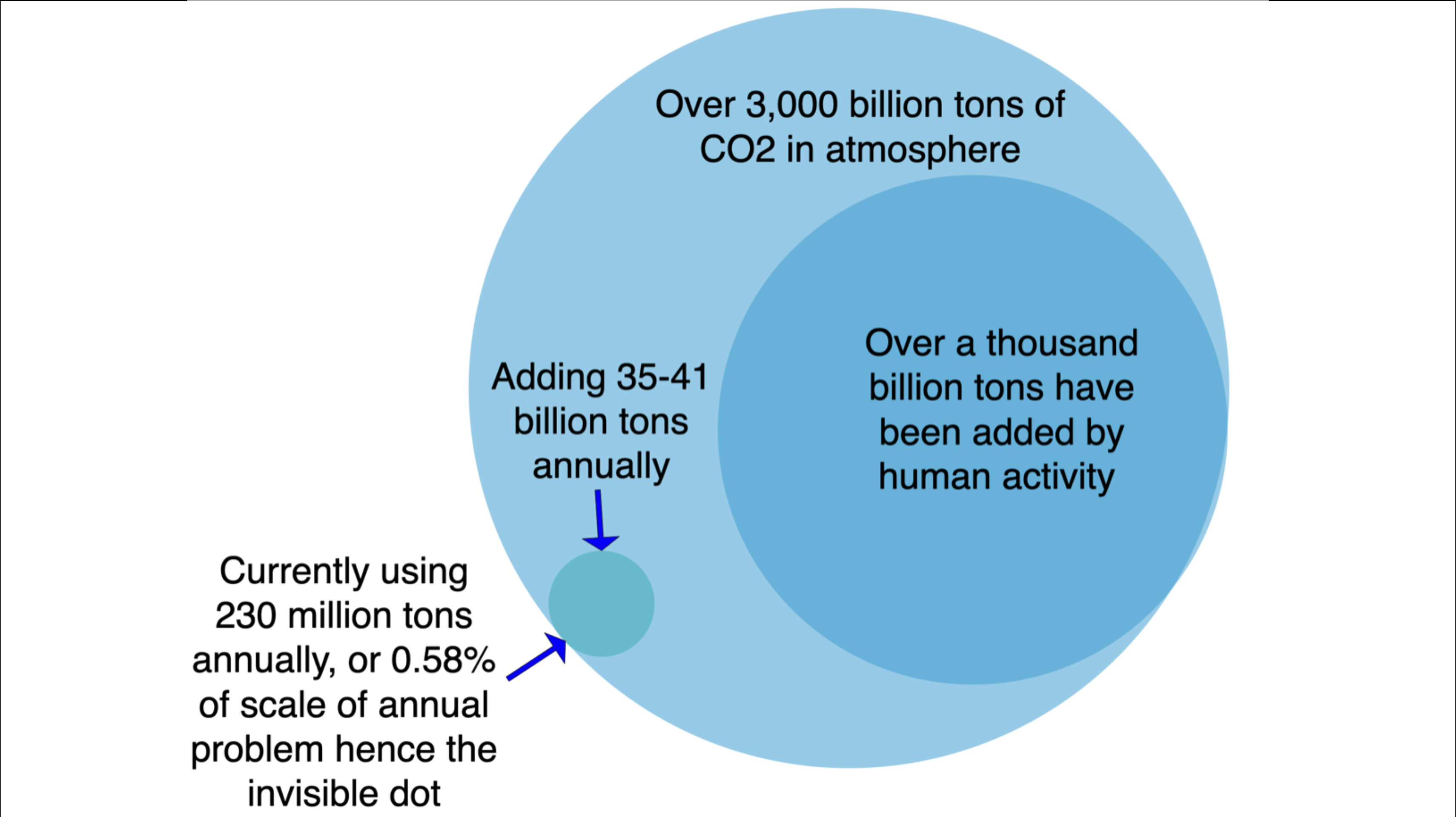
Michael Barnard (MB): Thank you Reji, and thank you as always to the ISGF for giving me the privilege of providing my context to the great country of India as it attempts to move forward into an affluent and low carbon future. It’s a tricky path to thread, but it is possible to Reji’s point regarding tacking carbon capture onto whole generation plants, I’ll touch on that later. It’s not just sulfur, is all I’ll say at this point. So I always like to start with the context for this. Right now, we have about 3000 billion tons of carbon dioxide, metric tons of carbon dioxide in our atmosphere, and we’ve added about 1000 billion tons since the beginning of the industrial revolution. Used to only be about 2000 billion tons. We’re adding between 35 and 41 billion tons annually. That’s just our annual.
It’s a lot of carbon dioxide that we’re adding. Now. From the usage perspective, currently we’re only using 230 million tons, or under 0.6% of the annual ad in carbon dioxide as an industrial feedstock globally. It’s used in greenhouses, it’s used in Pepsi Cola and stuff like that. And that’s the invisible dot. The scale of our entire usage is so small it doesn’t even register compared to the scale of the problem we’ve created. And so that’s fundamental statement number one. It’s a huge problem in terms of quantities, and we’re adding to that problem annually in very huge ways. Our entire market for carbon dioxide is a rounding error compared to that.
Now the other thing to know about the rounding error is that 90 million of those 230 million tons are used for enhanced oil recovery, mostly in the United States, although both China and India now explore are doing some enhanced oil recovery techniques as well. So that 230 million tons, you have to kind of actually say it’s only 140 million tons of carbon dioxide. That’s actually got to use today. We’re not going to scale 140 million tons multiple times to make it and find more uses for carbon dioxide that make that big enough to be material. Materiality is a key concept in this, fundamentally, because of the scale of the problem. We have to be talking 100 million tons a year for a particular solution to scale to in order for it to register as part of the solution. So think about those numbers.
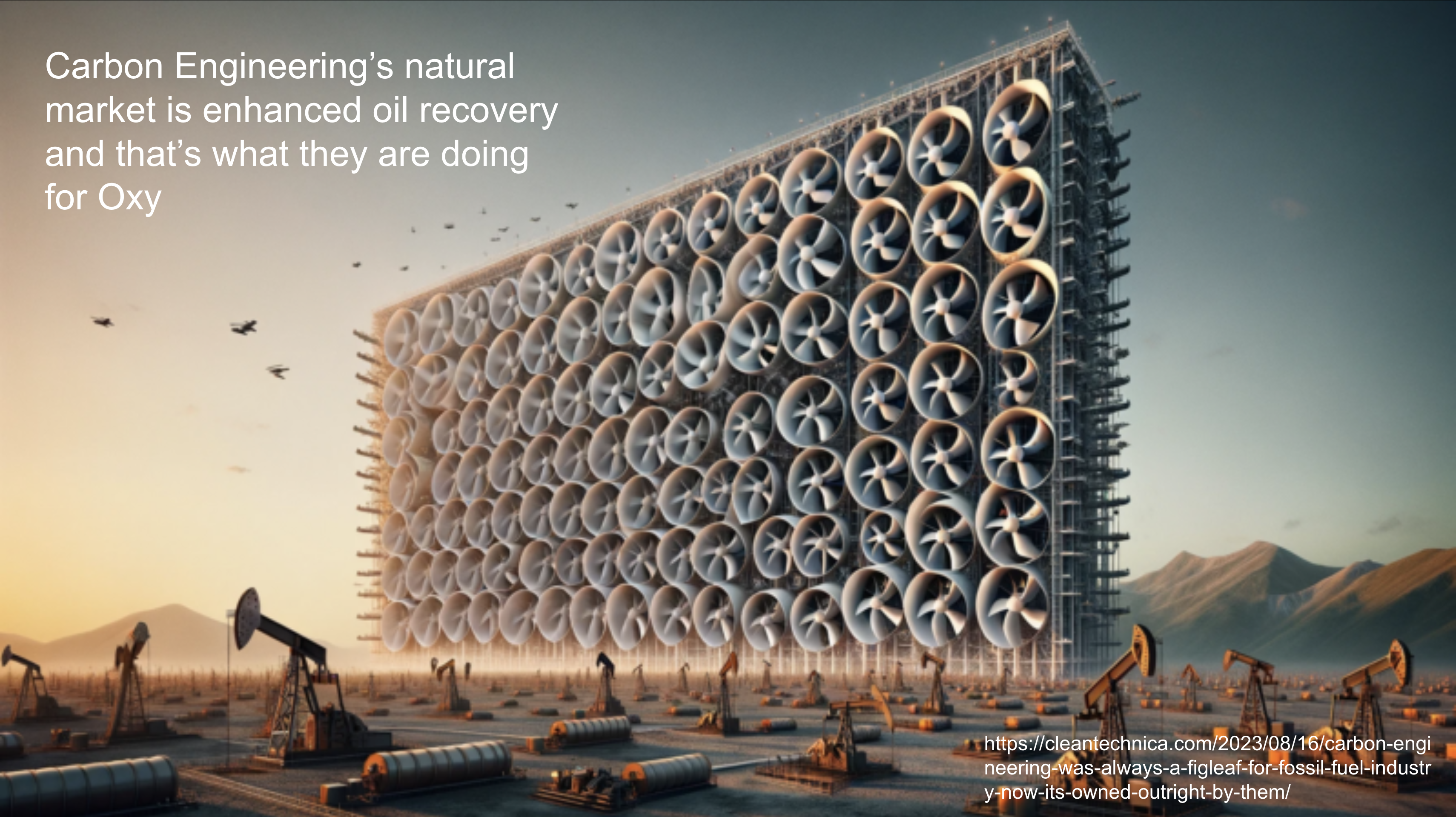
I’m going to step into a few examples. We’ve got a bunch of case studies in here. Carbon engineering is one of the big ones. It’s now being purchased by what used to be Occidental Petroleum. I did a big case study on it a few years ago. Its premise was that it was going to capture carbon dioxide from the atmosphere and make synthetic fuels. But to capture a million tons, only 1 million tons, that’s a hundredth of materiality. It would require a wall of fans 2 km long, 20 meters high, 3 meters thick, running 24 7365, and burning natural gas to power the entire thing. The only natural market for it is, oh, enhanced soil recovery. And that’s what Oxy, the rebranding, greenwashing rebranding of Occidental is using it for. In the Permian Basin in Texas.
It’s actually being built to suck CO2 out of the atmosphere while burning unmarketable natural gas and put the carbon dioxide underground to extract more oil from tapped out oil reservoirs. And when that oil is extracted and used as intended, it creates more carbon dioxide. This is a theme. It’s all part of the shell game of carbon capture and sequestration. And noted that. I’ll just refer back to one keyword in the title, mostly a shell game.
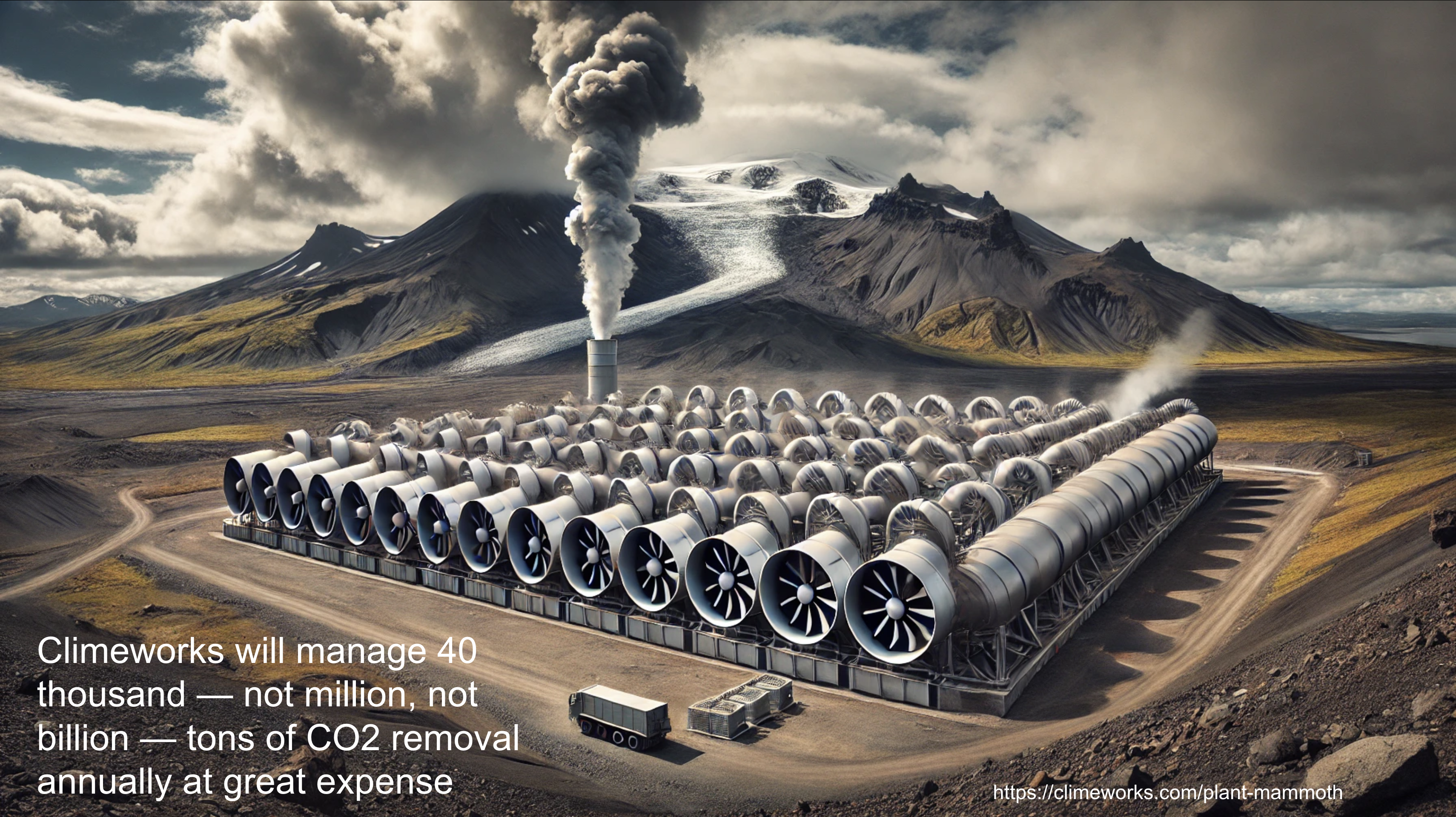
I’ll give you another example. Climeworks gets a lot of attention. It’s up in Iceland and it’s being expanded. It’s being doubled in size this year. That’s going to manage 40,000. That’s thousands, not millions, not hundreds of millions. Certainly not a billion tons of carbon dioxide removal annually at what is estimated to be about $1,000 us dollars per ton.
So it’s incredibly expensive carbon dioxide removal that isn’t scaling and won’t scale at that price, at that cost point. And to be clear, there’s nothing in the technology which indicates that it’s going to get cheaper. It’s not something like batteries, it’s not something like cell phones. It’s not something like appliances where billions of people are going to buy them in multiple quantities to drive economies of scale. It’s a big industrial facility, and the chemistry is not going to get magically better. So that’s enough about air carbon capture. But I want to talk about ocean carbon capture, because the ocean absorbs a lot of the carbon dioxide from the atmosphere. And that’s normally okay when we have the carbon dioxide cycle in balance, except that we don’t have the carbon dioxide cycle in balance.
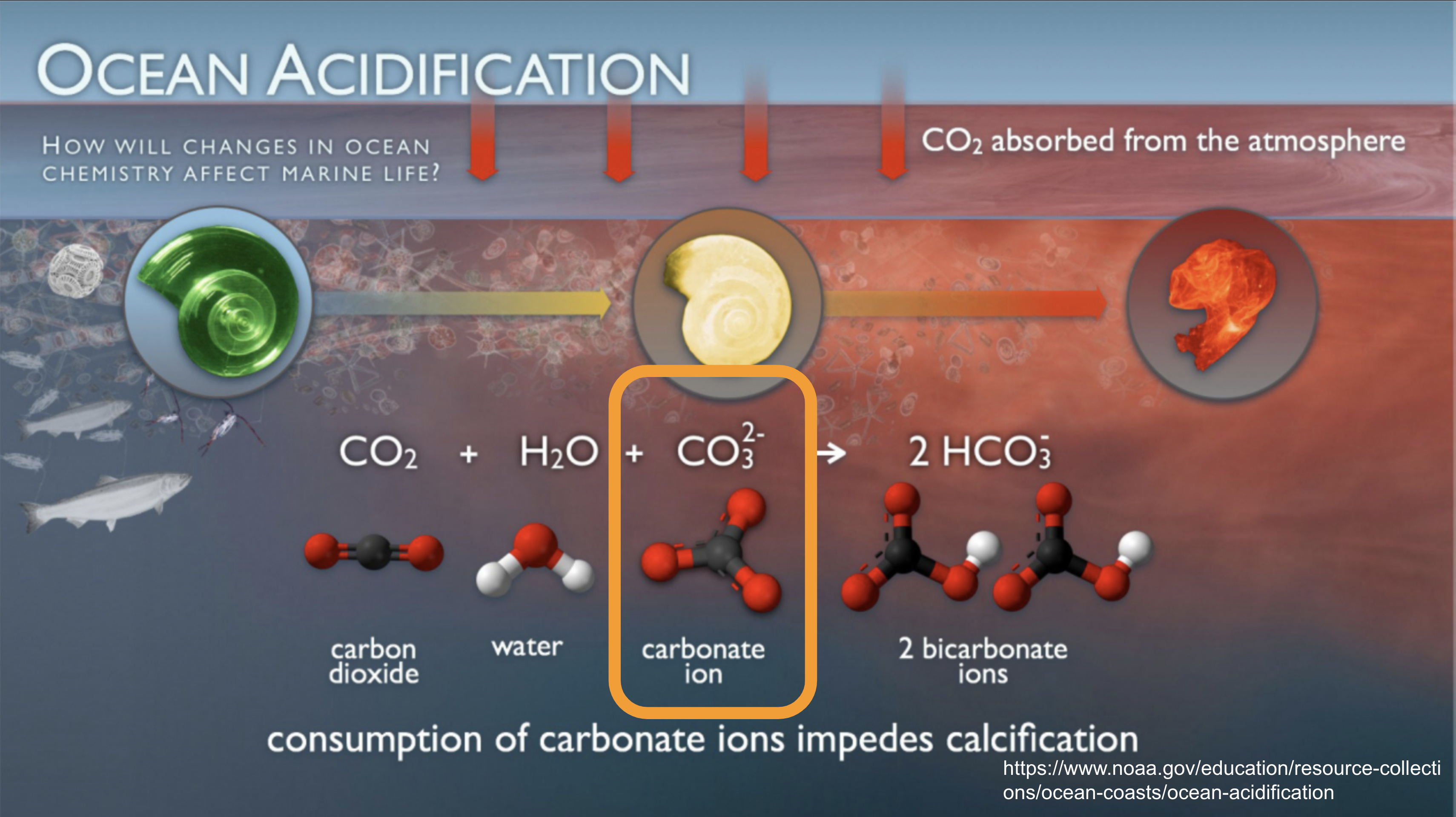
So now what’s happening is something that’s referred to as ocean acidification. Ocean acidification is best understood as reducing the alkalinity of the ocean. It’s a fairly alkaline water substance because it’s got a lot of salt in it. The challenge is different, though. The challenge is that carbonate ions are free floating ions that contain some of the carbon dioxide, and they’re floating in the ocean. They get used by shellfish to make their shells. They bind them into calcium carbonate shells to make their oyster shells and clam shells. But when carbon dioxide enters the water, it combines with water, and it turns into carbonic acid. And then it binds with the carbonate ion, and then it turns into bicarbonate ions. Now, bicarbonate ions take one carbon molecule from the water and one from the new CO2 from the atmosphere to make two bicarbonate ions.
And shellfish can’t use bicarbonate ions. So when we talk about ocean acidification, it’s making shellfish shells brittle because they don’t have the necessary carbonate ions. It’s a fundamental thing. Now, the second thing that happens when we do this is the more CO2 enters that ocean, the more it gets saturated. And the less CO2 can be added to the ocean, the less will be absorbed. So the ocean’s ability to absorb our excess diminishes. What this has led a bunch of people to say is, well, why don’t we increase the alkalinity of the ocean and therefore increase the CO2 uptake and reduce the warming problem? But adding more CO2 to the ocean just makes more bicarbonate ions and removes more ability for the shellfish to do their stuff. You’d think people would see this. However, lots of people are trying alternative things.
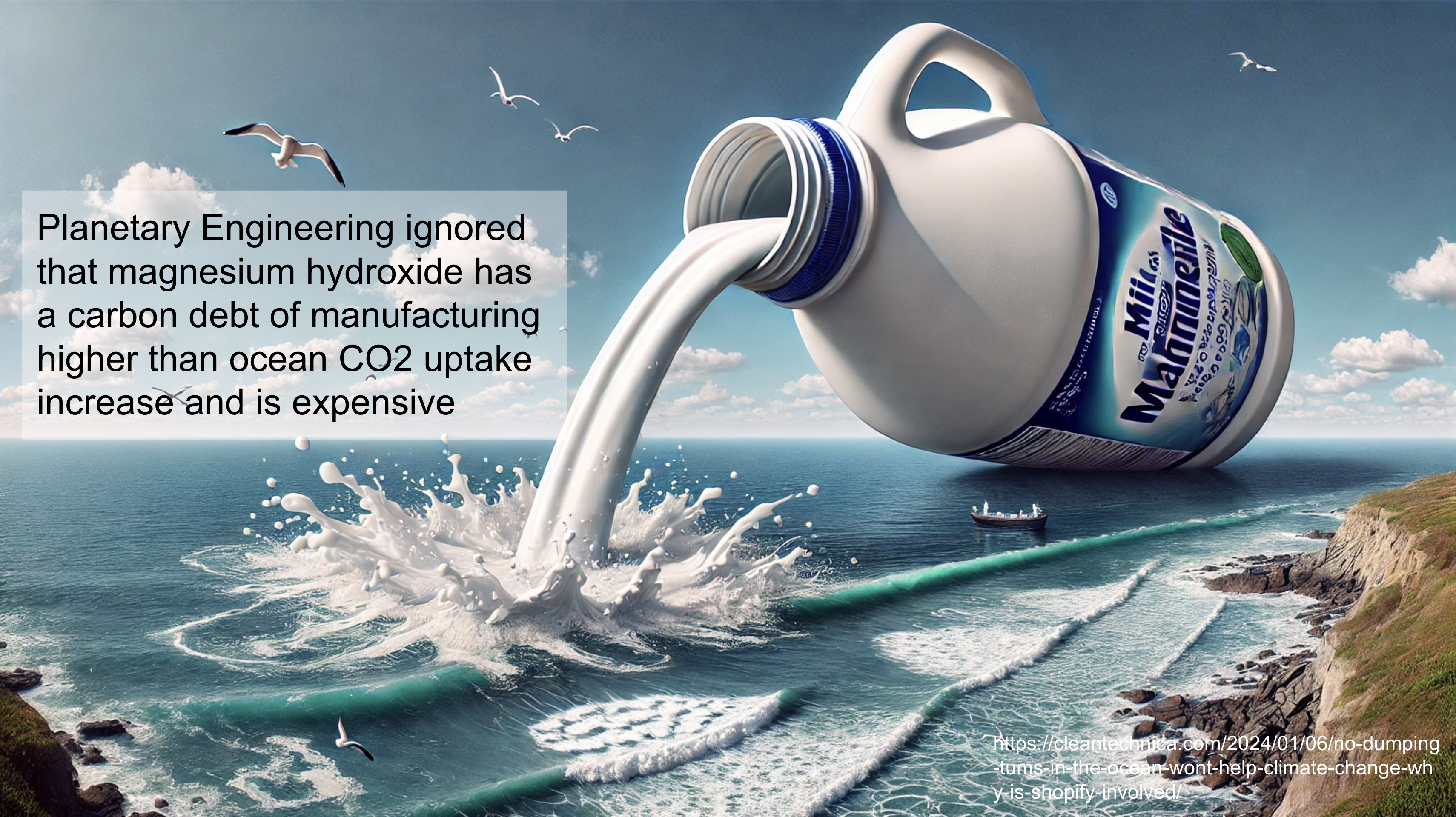
There’s a Canadian company called Planetary Engineering. They took research from a California PhD who’s been studying this for 30 years. All this is well known chemistry. All this is well known biology. All this is well researched pathways. And so, you know, startups who are claiming they’ve invented something new are probably just pretending they invented something new because there’s already academic literature on it. What planetary engineering did, and based upon the work of this people, is they said, let’s use milk of magnesia magnesium hydroxide, and we’ll pour it into the ocean, and it’ll bind with the CO2 to make magnesium carbonates instead and increase the alkalinity of the water and increase the CO2 uptake. This actually works. I’m not saying the technology and the chemical process doesn’t work.
The problem is manufacturing magnesium hydroxide is really expensive, so it ends up being really expensive, like thousand or more dollars per ton of excess carbon dioxide removed. And secondarily, magnesium hydroxide manufacturing has a carbon debt higher than the added ocean carbon drawdown. So these numbers are not hard to figure out. And yet this solution won the x prize for carbon drawdown. It won a million dollars US from that initiative from the X Prize foundation and Elon Musk. It set up two pilot plants, and only after it set up two pilot plants did it kind of realize it was too costly and it had a high carbon debt. So they’re actually trying to pivot now, but it’s par for the course. They just aren’t doing the basic techno economic assessments, and people are throwing money at these solutions that aren’t solutions.
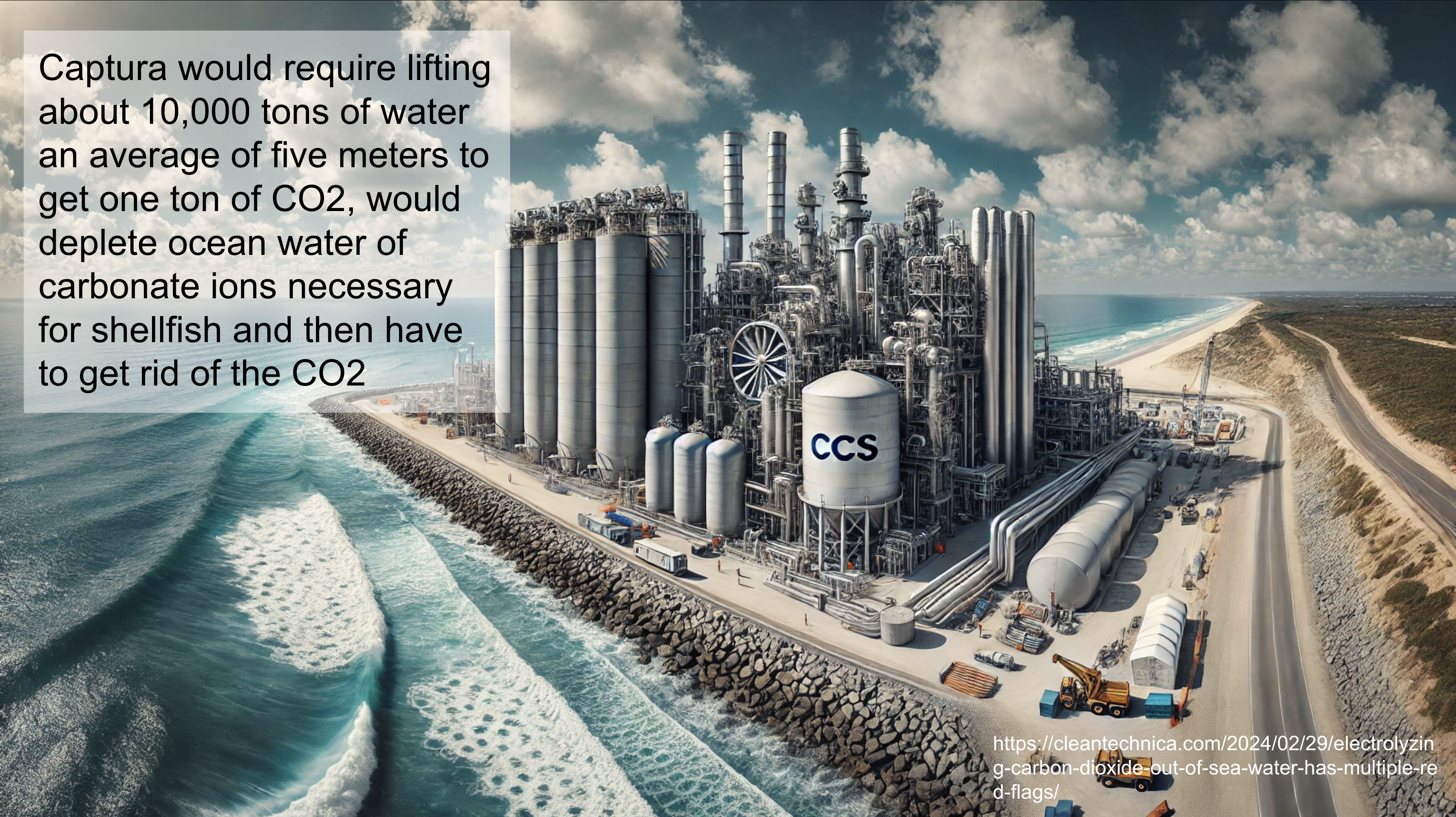
Captura is a bit better. It’s an electrolysis based solution. Brings up tons of ocean water up out of the ocean into an industrial plant, like a desalination plant, and uses, splits a bit of it off, electrolyzes it to make it more acidic, and then adds it back to the seawater. And then that unlocks the carbonate ions, bicarbonate ions, and then that bubbles out as CO2. They separate the CO2, and they pump everything else back into the water. And so that sounds great, and it works, except you actually have to lift 10,000 tons, 5 meters to get one ton of carbon dioxide. So the energy requirements are actually quite high. That 5 meters is just basically the tide. You’re going to have to actually get this into an industrial facility by the ocean, like a desalination plant. That requires moving seawater uphill.
Secondarily, you’re actually stripping the carbonate ions that shellfish need out as well. It’s just one of those things where they don’t have a biologist on staff, they aren’t looking at the downstream implications. And frankly, Captura is the best of the bunch as far as oceanic enhancement of carbon drawdown goes, and it’s not that great. So there’s another topic that’s worth talking about in carbon capture and sequestration, which is that we have to move the carbon dioxide places. The reason for that is because places to put carbon dioxide underground permanently in sequestration are not really anywhere near where we generate carbon dioxide. Our coal plants aren’t beside good geographical sequestration points.
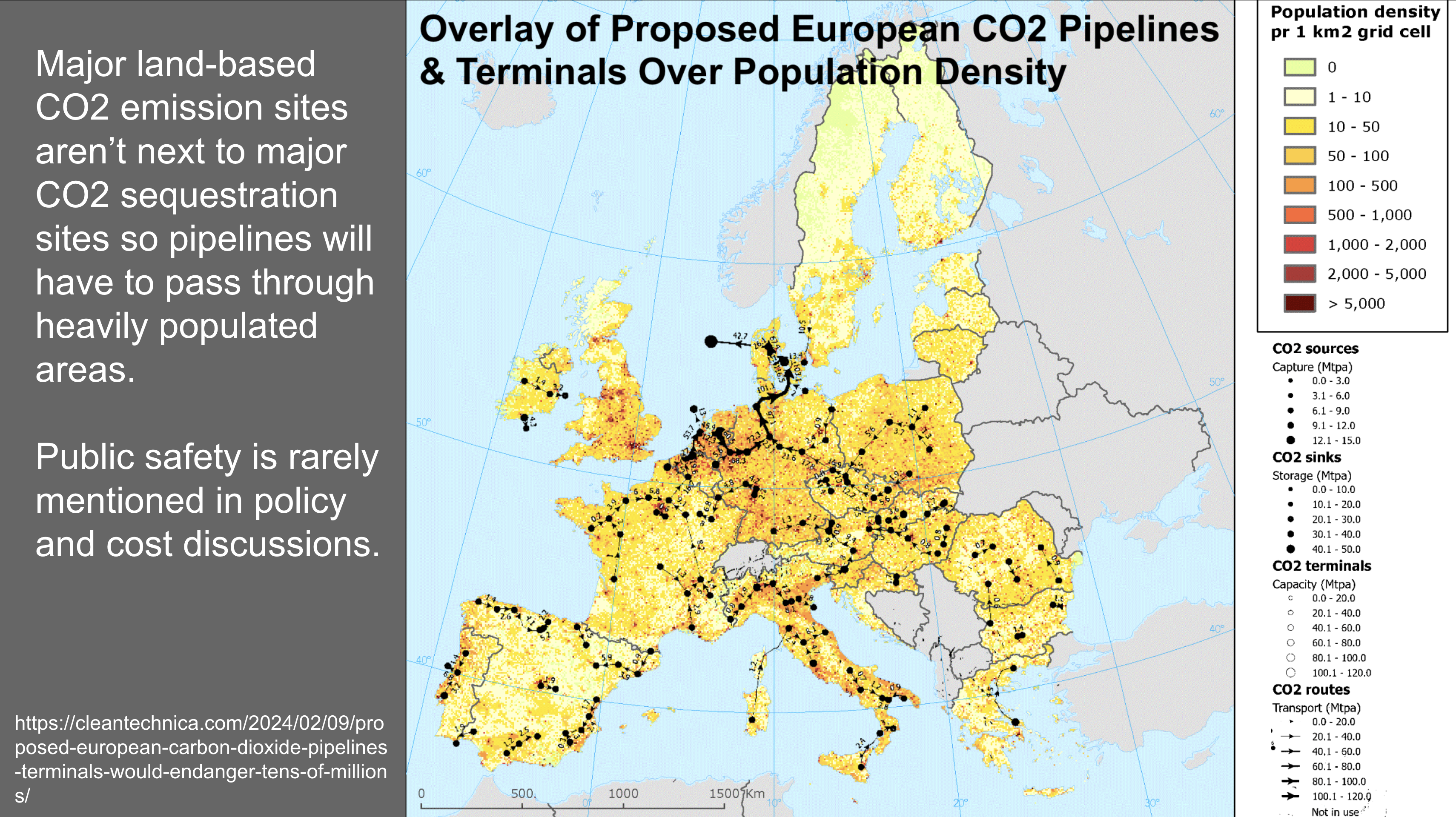
Our major industries that manufacture, like our refineries, that make a lot of carbon dioxide, well, they’re concentrated industries, but the places where it’s good to put carbon dioxide underground are distributed, and that means we need pipelines. We need the lowest cost mechanism for moving carbon dioxide around. In this context, Europe asserts that they’ll need about 19,000 pipelines that don’t exist today. By the way, this is all expensive new infrastructure. So in Mississippi, in Satarshu, Mississippi, a village of 46 people. That’s right, four, six. In 2020, they had a carbon dioxide pipeline running past their village, 1.6 km away. Why was there a CO2 pipeline there? Well, because it was carrying liquid CO2 to an enhanced oil recovery field. Yet again, enhanced oil recovery rears its ugly head.
The problem was that there was some excess precipitation in the area. The land slipped, the pipeline separated. A pipeline separating is normally not a big deal. Excuse me, I’m just going to get a glass of water. The pipeline separated, and then the liquid CO2. The liquid CO2 turned into gaseous CO2. The gaseous CO2 expanded. The gaseous CO2 expanded 590 times the volume of the liquid CO2. Normally, this would be okay because, well, it’s gas, so you’d expect it to just dissipate in the atmosphere. But carbon dioxide is heavier than nitrogen and oxygen. It doesn’t dissipate automatically. It doesn’t just dissipate immediately. It forms a blanket on the ground that’s 10 meters thick and rolls downhill and fills pockets. And it rolled downhill into Satartia, Mississippi, 1.6 km away.
It rolled across a highway that was between the pipeline and the village. People in a rest stop on the highway in their car, just taking a break from driving, were left unconscious and gasping for air because they can’t breathe. Carbon dioxide cars wouldn’t work in Satartia; most of the people who lived in the town were left unconscious on the ground. Over 200 people were evacuated. Emergency vehicles couldn’t get into the town hours after the event. Inside rooms, inside buildings. In Satarsha, elevated levels of 30,000 parts per million were recorded inside those buildings, which is, by the way, life threatening. It’s an asphyxiant. And so what does a small village in a remote part of an underpopulated state in the United States have to do with carbon capture sequestration built large?
Well, the pipeline plans in anything which uses carbon capture and sequestration and scale, have to put pipelines through heavily populated parts of our countries, because that’s where we generate a lot of carbon dioxide, and it has to go through those parts to get to places where there’s offshore or undersea stuff. If we look at this map, up here in the Rotterdam area in the North Sea is where they expect to put a lot of carbon dioxide underground in sequestration facilities. And this is a very heavily populated part of Europe. The darker portions of the map are population density. I created this just to overlay the pipeline infrastructure over the population density map for Europe to give a sense of this is a significant risk. And there are some mitigations.
You can put gaseous CO2 pipelines through populated areas, for example, but gaseous CO2 is almost 600 times the volume, and so you can put a lot less through a much bigger pipe, so it’s a lot more expensive. So public safety hasn’t been coming up in these, but it needs to hold on.

Another example, Sleipnir in the North Sea is often touted by Equinor as an amazing carbon sequestration facility. But it’s taking carbon dioxide mixed with natural gas from under the North Sea, lifting it to the surface, separating the CO2 out because there’s too much of it, and putting it back underground for tax breaks. This isn’t CO2 sequestration. This is just cleaning up after a mess we’re making a little bit. And they’ve made about €1.2 billion of tax breaks the last time I checked for this.
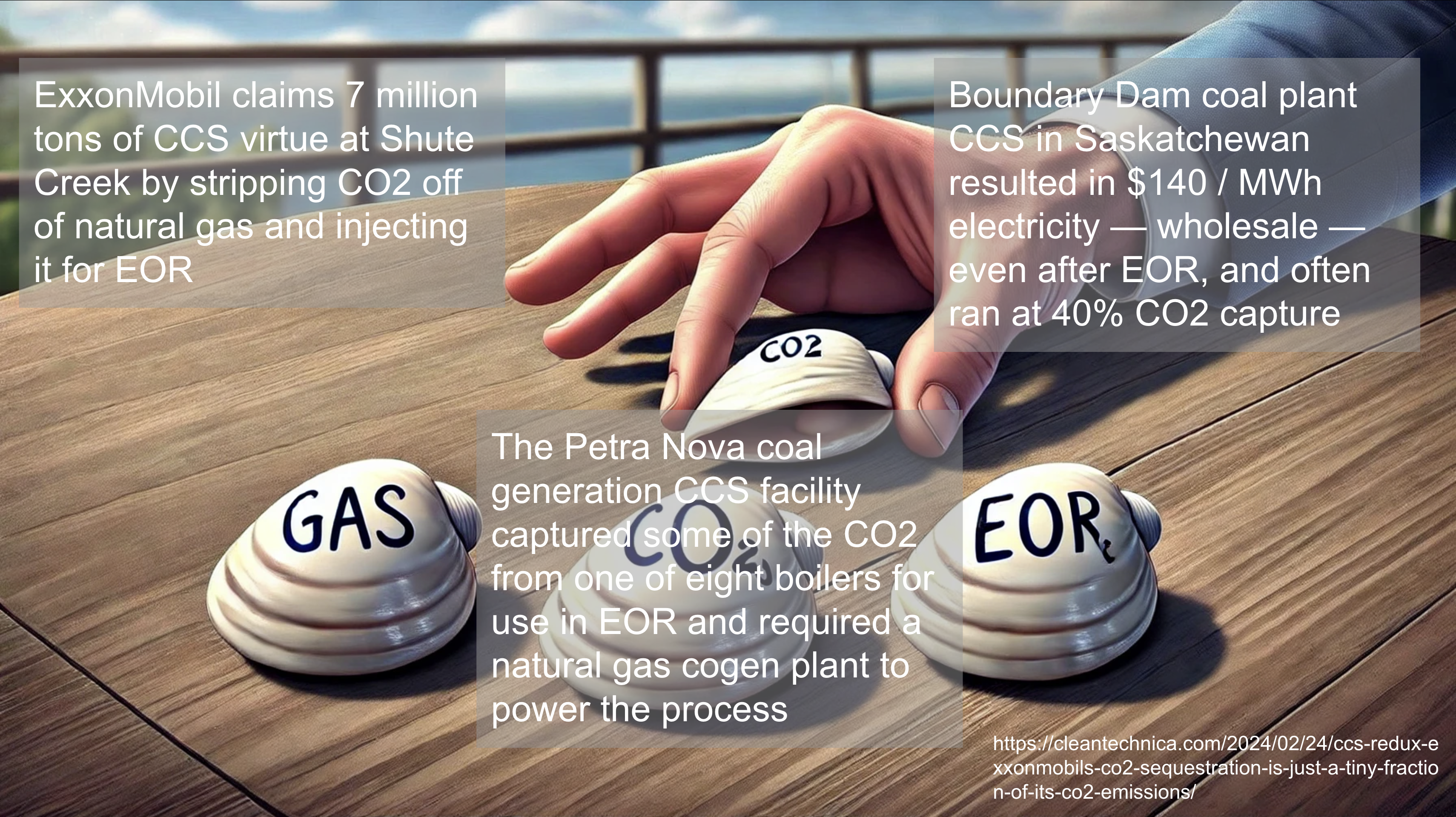
Another piece of the shell game question is back to putting bolting carbon capture onto power generation. There’s a couple of examples here. Boundary Dam in Saskatchewan and Petronova coal generation in the southern United States both attempted this. They both bolted carbon capture onto coal generation plants. In the case of Petronova, they had eight boilers in the coal plant. They put carbon capture onto one of them. The parasitic power draw of the carbon capture technology was so great, they had to build a gas plant to power it, because otherwise they couldn’t meet their coal plants contractual obligations to deliver power to customers. When you have to build a gas plant to power a full plant’s carbon sequestration, you know something’s not quite right. Both in Petronova and Boundary Dam, they were somewhat successful in capturing carbon in CO2.
It’s not rocket science, but the cost was so much that even though both were used for enhanced oil recovery enhancement and were getting paid for the carbon dioxide, they were capturing and getting governmental subsidies, neither of them was remotely economically viable. In Boundary Dam, it’s $140 per megawatt hour, as the wholesale price of electricity. And the government of Saskatchewan said, well, now that we’ve done this, we’re never going to do it again, because it’s just way too expensive. Petronova, the carbon capture community, claims it’s a success. But from the outside, it’s successfully proven the technology can work, but not remotely, that it’s remotely viable, economically or scalable. Remember, one boiler of eight in a single plant, and they had to build a gas plant to power it. The EOR part is the shell game part.
And nothing exemplifies the shell game of carbon capture more than ExxonMobil’s Shute Creek facility. What they do in ShuteCreek is they take natural gas from underground, just like in the Sliepnir facility, and it has too much carbon dioxide. So they strip off the carbon dioxide, and then they pipe it a few hundred kilometers to places that need carbon dioxide for enhanced oil recovery, and they shove it underground. So they’ve taken carbon dioxide out from one place, put it in a pipeline to another place. They’re shoving underground in that other place to do more enhanced oil recovery, to get more oil out, to burn the oil, to make more carbon dioxide. And they claim virtue for this. But here’s the other thing. If they don’t actually have a customer for the carbon dioxide, they just vent it to the atmosphere.
So they’re actually making a lot, venting a lot of carbon dioxide to the atmosphere at the Shute Creek facility and selling some of it for enhanced oil recovery. This is not a virtuous story or remotely a climate solution. Yet ExxonMobil claims that they are the most, they have the most sophisticated and greatest volume of carbon capture and sequestration of any facility in the world. It’s just a claim that doesn’t stand up to scrutiny.

Now, also, a few years ago, three or four years ago, I looked at every carbon capture and sequestration facility globally that was sequestering at least a million tons of carbon dioxide a year. Remember, 100 million tons is material. A million tons is not material. But these were the ones that were at least over a million tons.
So we could at least talk about them without, like, Climeworks wondering why anybody was talking about them at all. And what I did is I went back to 1972, when the first of these efforts were built, and I went through time, and I captured the capital costs of these. Not the operating costs, just the capital costs. And I then said, okay, at that time, how much did wind and solar cost? And then I did math to figure out how much wind and solar we could have built through that time. And then I figured out which ones were enhanced oil recovery, virtually all of them. And gave them every benefit of the doubt that they would actually sequester some net carbon, even though they’re doing enhanced oil recovery.
And what I found was that we would have, even if we gave them every benefit of the doubt, just building wind and solar would have avoided a lot more carbon dioxide being emitted than any of them sequestered, than the total of them sequestered over those decades. And this is a fundamental thing that it boils down to for carbon capture. Carbon capture. The best thing we can do when we’re in a hole is stop digging the hole. Carbon capture is a teaspoon, taking a little bit of dirt out of the pile beside the hole and putting it back into the hole, while we continue to use the massive front end loader to scoop buckets of soil out of the hole.
Wind and solar renewable generation avoids digging the hole, and it’s much more cost effective than trying to take carbon dioxide out of the air or capture it from coal plants or other things. It’s the cheapest way to reduce the carbon dioxide entering our atmosphere. Now, that doesn’t mean we don’t have to do some stuff, and that doesn’t mean there aren’t places for carbon capture.
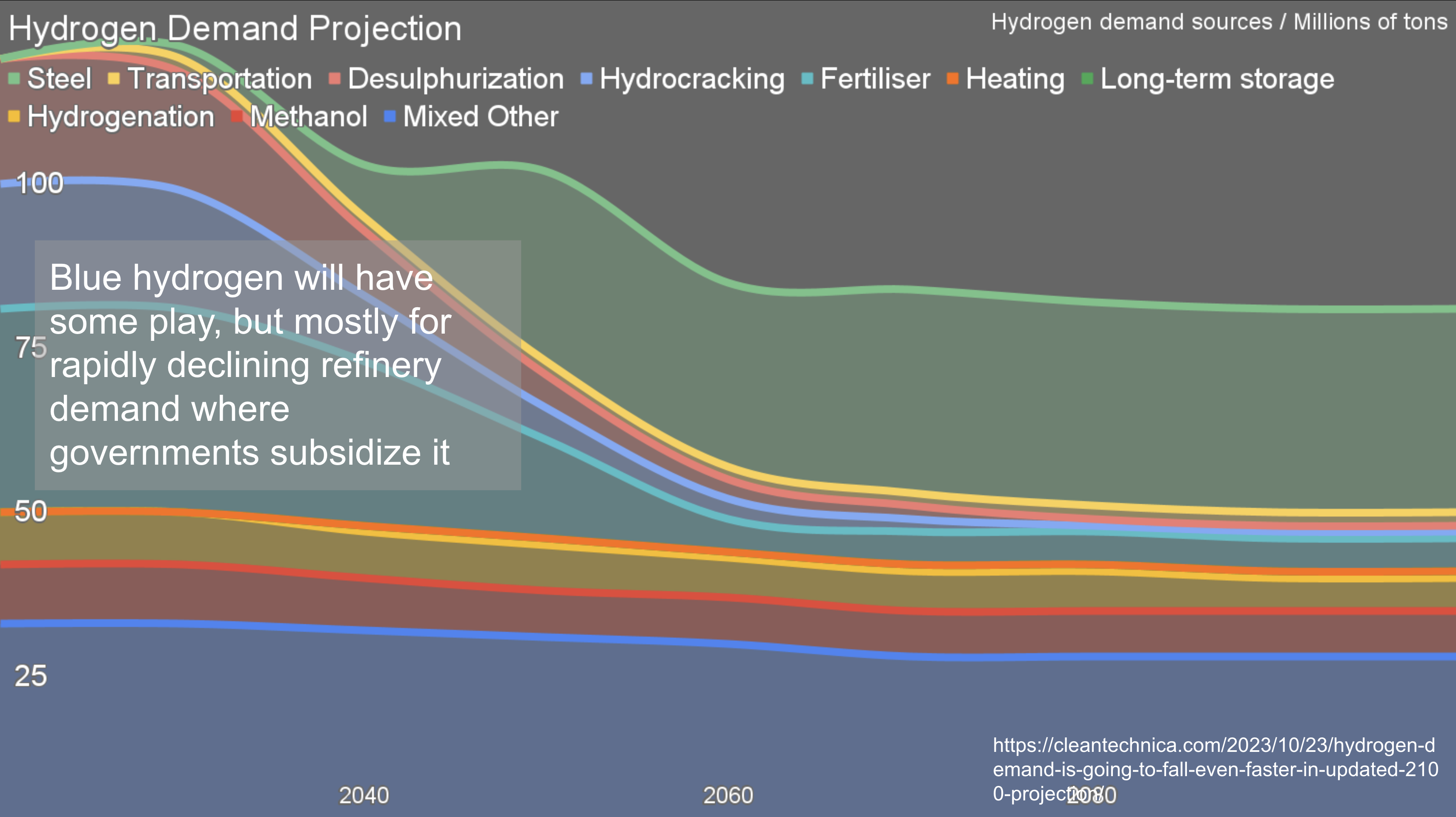
A little bit of foregrounding. The next and last seminar in this series will be on hydrogen, which is being vastly hyped. This is my somewhat heterodox projection for hydrogen demand through 2100. Sharp eyes, not even particularly sharp eyes, will note that demand is going to go down. I’ll get into the explanations for all that in a couple of weeks. But this gets to blue hydrogen, which is a big place where carbon capture is promoted.
Blue hydrogen is basically just gray or black hydrogen, which we take coal or gas, and we use reformation technologies to separate out the carbon from hydrogen, the carbon gets bonded with oxygen from the atmosphere to make carbon dioxide. And theoretically, we use hydrogen for stuff. Well, hydrogen is a carbon dioxide problem today. This is why carbon dioxide, or hydrogen today, is a global warming problem on the scale of all aviation. I’ll just repeat that. We have so much carbon dioxide coming out of manufacturing hydrogen today that it’s at the same scale as all of aviation everywhere in the world. It’s a climate problem more than a climate solution.
The premise of the oil and gas industry is what they’ll do is they’ll take their hydrocarbons, they’ll reform them, but they’ll bolt on that expensive energy sucking carbon capture solution onto the reformation plants, and then they will put the carbon dioxide somewhere. And they’re asking governments for a lot of money for this. That might happen, but it, once again, gets back to that problem of cost and scale, and it does significantly increase the cost of that blue hydrogen and to the point where it becomes a real question mark in terms of techno economics for transportation and other end use cases. But there is going to be some blue hydrogen.
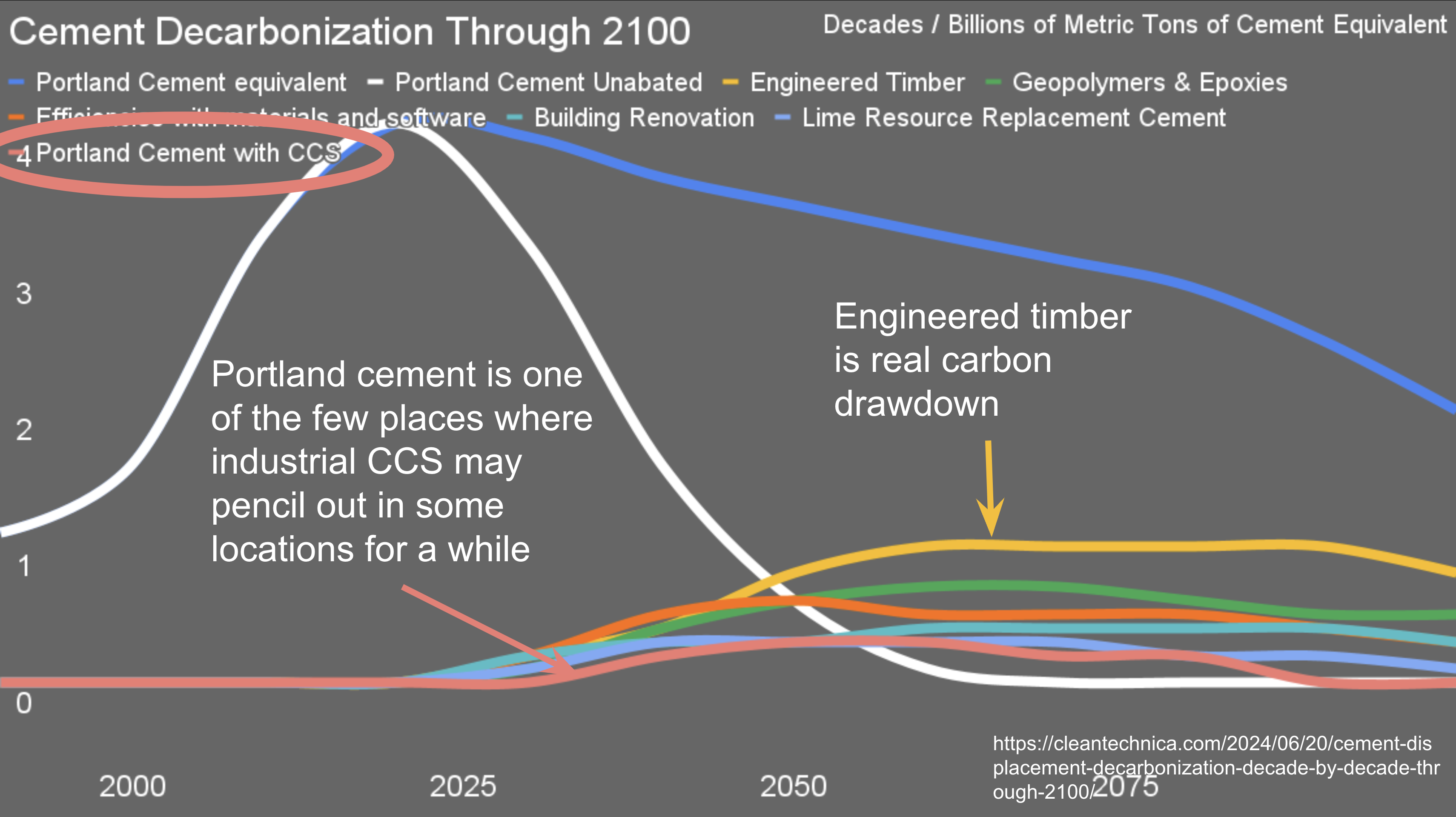
Cement is another place. Cement is a big carbon problem, a big carbon dioxide problem. I like to think of limestone, what we make Portland cement from, as kind of that other fossil fuel, because limestone has got carbonous and oxygen bound with calcium. And then we heat it up to about 900 degrees celsius and bakes off the carbon dioxide and leaves behind quick line, you know, a calcium oxide, the calcium oxide we combine with clays, and we rotate them in a drum with more heat and some silicates, and we make Portland cement nodules, basically a little ceramic, and we crush that. We make buildings out of it. But earlier this year, I finally got around to doing my cement decarbonization projection through 2100, how we’re going to do it. And there is a bunch of stuff in there. I’ll just foreground a few of the big ones. A big one is declining demand.
This projection of demand is going down for a few reasons. One of them is China’s finished its major infrastructure buildup. So the iron and steel it’s been hammering into the 500 cities it’s built, the 177,000 km of highways it’s built. The net, currently around 45,000 km of high speed electrified rail. They’ve only got about 7,000 to go before they’re finished in their projections. All those things they’ve built, well, they’re slowing down on their building and so that means demand for cement is going to go down. Then we have cross laminated timber or engineered timber or mass timber, various terms for the same thing, which will do it.
And then just reusing buildings because we’re going to have a declining building stock, we’re going to have a population which achieves is, you know, we’re going to have peak population between 2050 and 2070. And at a certain point we just don’t need more buildings because we’re not, you know, making more people. And so we can start reusing buildings more. So those are declines. But this is one of the few places where carbon capture on a traditional or modern cement plant might make sense. It will pencil out economically. I did the cost assessments for this. Basically, if you have a cement plant that happens to be geographically right next to, you know, within 100 geological formation, which is suitable for long term sequestration of carbon dioxide, it probably pencils out to just make cement and put carbon capture on that plant.
Now there’s some additional electrochemical technologies like Sublime’s, which would make this a bit better, but carbon capture actually might make sense in cement. It’s one of the few places where it’ll probably pencil out.
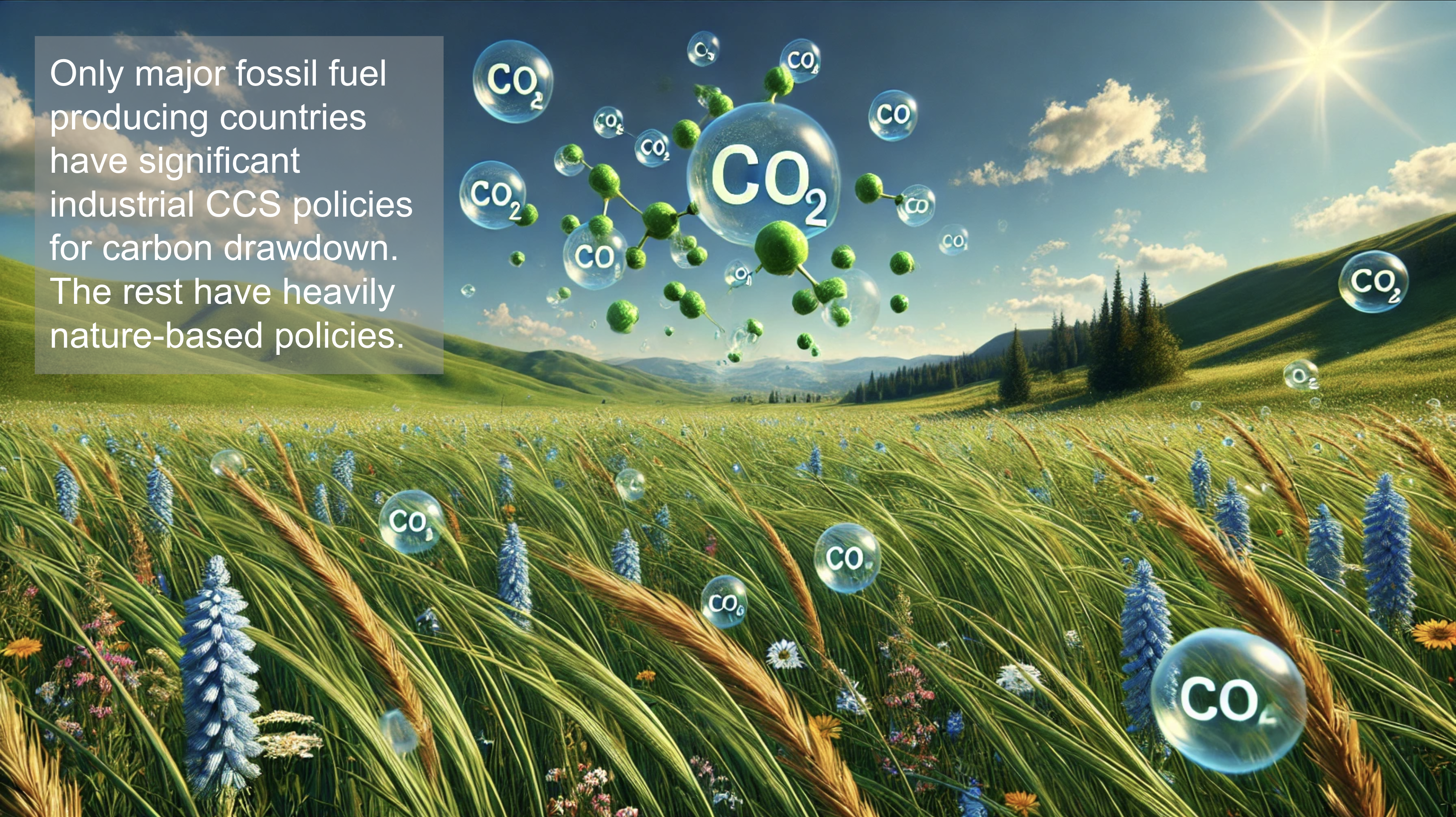
So there are some places, but it gets back to that thousand billion extra tons of carbon dioxide in our atmosphere. And what are we going to do about that? Well, we’ve kind of looked at this and the IPCC six has a list of six major carbon drawdown approaches. The six major carbon drawdown approaches are nature. Nature, nature, nature. And on the 6th, one heavily lobbied for by the oil and gas industry and nations which have lots of oil and gas. Oh, mechanical and industrial carbon capture drawdown methods, kind of those ones of bolting on carbon capture to fossil fuel generation systems.
So as we look across countries, what we find is countries that don’t have major oil and gas industries don’t, aren’t depending on their policies for carbon drawdown from geological sequestration of carbon dioxide. They have saline reservoirs that are suitable for carbon sequestration underground. But they’re just saying this doesn’t make sense. It only makes sense to the people, to the nations which already have major oil and gas industries, which depend upon carbon capture being a mechanical carbon capture of fossil fuel emissions being a thing in the future. And so just kind of like to sit there and think and say, well, what could we do instead? In India, of course, you’ve got significant mangrove forest, coastline, deforestation challenges. Renewing those would radically increase your carbon drawdown emissions and stuff like that.
It’s not a slam dunk and it’s not certainly not going to help us by 2050. But carbon drawdown is best thought of as something for 2200. The amount of CO2 in the atmosphere is going to keep paying negative dividends for centuries. And so we have to slowly draw it down to probably around 300 parts per million. Nature is the way to do that. It’s the only scalable, automatically replicable, inexpensive way to do it. And so we have to change our land practices and a bunch of other stuff. And that’s it for my presentation. We have some time for conversation.

RKP: See if there are any questions.
Sanjeev: I can do one verbally if you don’t mind. This is Sanjeev. Reji. So Michael, I was just wondering when you look at your scenarios where demand for cement would go down because China’s everything that they needed to, you’re kind of ignoring what India might be up to over the next 2040 years or so. Because admittedly we don’t have a great history of growth. But if things perk up, then India could be in a way the next China as far as demand is concerned, plus some more. But you don’t factor that into your chart. So I was wondering why.
MB: Oh, you’re incorrect. I do factor in it, I just didn’t mention it. Normally when I talk about my projections through 2100, what I assert is the incredibly rapid growth and infrastructure build out that China drove itself through over the past 45 years is unprecedented globally and will not be repeated at that rate or scale by the emerging nations of India, Brazil or India. Their growth will be faster than it has been historically, but it won’t be at that scale. Further, they are not pursuing industrialization policies that are anything on the scale or magnitude of China. And so while their demand will increase, it will be more than offset by the scale of China. Every time I do the math on China, what I find is like for example, let’s just take steel. I’ve got a steel projection through 2100 as well.
China manufactured in 2020 half of all the steel in the world. The next biggest manufacturer was India and it was a 10th the size. India doubling its steel manufacturing as part of the, you know, its growth process over the next 20 years, that’s a massive growth for India, still only replaces a 10th of China’s total output, and China’s probably going to diminish by 50% into a maintenance cycle over that period. What I look at in terms of these things is the likely growth patterns China has. When it liberalized its economy in the 1980s, India started doing some export, but it did not fundamentally create nearly as significant export markets for its industrial manufactured products as it did for other products and for its services.
Having worked in the global tech industry, I’ve been working with Indian teams with Tata and other firms through IBM for decades. And so the intellectual exports that China was that India was doing are very low carbon compared to the washers, dryers, ships, exports of other treats. I also worked in Brazil and their exports are heavily resource extraction based, dominated by both minerals and agricultural products, bulk products there. And they are not building the industrial base for export that China did as well. Similarly, Indonesia is doing a bunch of interesting stuff, but it’s not building that industrial base. And because of the way our economies are structured, we’re not going to see that scale of build out again. India is already a fairly urbanized country. It’s not as heavily urbanized as it will be. It still needs to do a lot of urban development.
But China came out of the Mao period with everybody being thrown out of cities to be rice farmers at a completely counterproductive pace. And the cities rotted and fell apart. They had to build 500 cities from scratch. I don’t see the rest of the world building 500 cities from scratch in the next 40 years. So I hope that answers your question. It is considered. I forgot to mention it when I was articulating China’s drawdown.
Sanjeev: Thank you. Thanks.
MB: We have a question in the text. So what are the material challenges in carbon dioxide transportation? Well, the first material challenge is that when we burn any fossil fuel, we get two to three times the mass of carbon dioxide. So it’s like if you ordered some food for takeout, for delivery, and the guy came, the delivery person came on their electric bike to your door and handed you a bag, and then when you opened the bag and ate the food, you had three times as much leftovers and that you couldn’t eat as the foods that you ate. That’s what the problem is with burning fossil fuels. Carbon in the fossil fuel combines with oxygen from the atmosphere to triple its mass.
And it not only triples the mass, if you burn coal or oil, well, they’re liquids and solids, which are very dense forms of carbon. But as we bind them, the carbon in them, with oxygen from the atmosphere, well, that’s a gas. And once again, it’s very diffuse. So not only is the mass a multiple of the feedstock, but the volume is multiples of the feedstock as well. It’s a waste stream. A hidden benefit historically of fossil fuels is that when we burn them, a lot of the waste, the biggest by far, mass and volume of waste, removes itself because it just goes into the atmosphere and diffuses. This is basic science, but it’s invisible to us, so we don’t think about it. So let’s just take a natural gas plant. A natural gas plant has a pipeline coming into it.
It burns a bunch of natural gas, and then for every ton of natural gas that comes in, three tons of a new gas get created. So that means we have to build a pipeline out of the plant that’s three times the size. That takes three times the energy to move the gas. And so we end up with all sorts of costs and efforts associated with that. Further, when we’re putting that gas back underground, well, when we take oil out of a reservoir, for example, well, that’s oil. It’s once again a dense form of carbon. But we’re putting a non dense form of carbon dioxide back underground, which is why a lot of sequestration things are using supercritical CO2. They pump it down as that kind of liquid solid or that liquid gas mixture. That’s the supercritical phase.
There’s a whole bunch of technical complexities that arise with that. It takes energy to compress carbon dioxide to its liquid form. It takes energy to keep it compressed through a pipeline thing. Now, once again, these are all solvable things technically, but they become unviable economically, and they bring in safety concerns. I’ll just say that there is no other industry where the waste stream is three times the mass of the input stream. It’s just a scale problem. Other waste things that we deal with. The waste is a fraction of the input streams. So that’s the fundamental problem. There are no technical problems that can’t be overcome with sufficient money, but that money’s all going to be governmental, and it’s going to be governmental money that’s going to persist for decades or centuries.
It’s much better to build wind and solar and avoid burning the CO2 in the first place. It’s much better to restore wetlands, grasslands, mangrove swamps, plant more trees, adjust our agricultural practices so they sequester instead of releasing carbon dioxide than it is for other stuff. I hope that answers your question. Parvatula.
Parvatula: Okay. Natural materials absorb CO2 slowly, but the rate at which decarbonization drive is planned will take longer. If you stick to your suggested approach, going to nature alone will not solve the problem in near term. Please give your comments absolutely true. The entire premise of carbon drawdown to meet 2050 goals is fundamentally flawed. Their carbon drawdown will not address that.
MB: It is being included because the IPCC has been heavily lobbied to include carbon drawdown and because people aren’t seeing the other levers that we can do. And this is a really clear statement of a conservative thing. So carbon drawdown is included in the IPC season areas because they don’t know what else to do. That doesn’t mean it’s going to work. That doesn’t mean we can scale mechanical or nature based solutions. Excuse me. Neither are going to scale rapidly enough to solve the problem. Solving the problem requires a very accelerated rate of transformation of our energy and transportation systems, our land use systems. To avoid releasing a lot more CO2, we have to do that in a very accelerated way. Hence the triple renewables by 2030.
Now, the good news here is that dirt cheap solar panels, the glut of solar panels means that massively more solar is being built in the developed and developing world. As we speak, wind energy is continuing to grow. It’s just being overshadowed by solar. Wind is still incredibly cheap, incredibly dominant, and very fast. We have hydroelectric resources that are untapped. As I found yesterday, there are 2,500 existing dams in the United States which aren’t being used to generate electricity. They’re being used as reservoirs for irrigation and stuff. And so we have a significant amount of untapped hydro generation. We have all the tools at hand to radically reduce our carbon emissions. And the requirement there is to be very serious about electrifying everything everywhere, all at once.
China has electrified its economy more than the rest, at a much faster rate than the rest of the world, because it’s economically sensible. They are ahead of the rest of the world in terms of electrification of their economy. They’re ahead of the rest of the world in terms of electrification and transportation, heating, cooling, all those technologies that are necessary to use electricity. And they’re ahead of the rest of the world in terms of deploying wind, solar, hydro, transmission and storage to deliver energy to those end use cases. They’re ahead of the world in terms of industrial electrification. That’s the path to follow. Look at everything and say, how do we convert this to electricity? And how do we massively increase our electrical delivery to do this? We can do this.
Carbon drawdown is not the answer to climate change by 2050. It’s a pipe dream. It’s giving us the belief that a maid will follow us around, vacuum up, or. And sweep up our messes. I just want to say that’s unrealistic.
Have a tip for CleanTechnica? Want to advertise? Want to suggest a guest for our CleanTech Talk podcast? Contact us here.
Latest CleanTechnica.TV Videos
CleanTechnica uses affiliate links. See our policy here.
CleanTechnica’s Comment Policy





